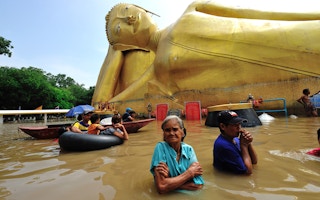In 2013, Japan was the only nation in Asia to crack the top 20 of the Global Sustainable Competitiveness Index. The index compares 176 countries based on four key pillars (with 73 sub-indicators): the availability or depletion of natural resources, the efficiency with which those resources are being used, the creativeness of the economy and social cohesion.
Despite the economic boom currently taking place across Asia, businesses are lagging in their responsibility to grow sustainably.
This month, DNV GL is celebrating its 150th anniversary in several key Asian cities and we are using the occasion to specifically focus on the unique sustainability risks facing the region.
Climate change is becoming an increasingly undeniable part of Asia’s new risk reality. Water stress and increasingly frequent extreme weather, droughts and heat waves are already disrupting our agricultural systems, our electric grids, our cities and our rural communities.
Across industries, businesses have assets, operations and supply chains that will be directly affected by emerging climate risks. We also rely upon the infrastructure and the communities in which we work – and will struggle to succeed if these fail. From severe monsoon flooding in the Himalayas to intense typhoons in Southeast Asia, evidence is mounting that our 20th century institutions and infrastructure are inadequate to deal with 21st century risks.
The greenhouse gases that have already accumulated in the atmosphere make further climate change inevitable over the coming decades. Mitigating climate change by reducing greenhouse gas emissions, reversing deforestation and improving efficiency is more urgent than ever.
But at the same time we must also adapt to the changes in the climate that we’ve already started to experience. Perhaps more than anywhere else, this is relevant in Asia. With so many densely populated low-lying and island nations, severe weather and rising sea levels stand to critically impair economic activities and societal structures.
“
Across industries, businesses have assets, operations and supply chains that will be directly affected by emerging climate risks. We also rely upon the infrastructure and the communities in which we work – and will struggle to succeed if these fail.
Therefore, businesses have much to gain from investing in building more resilient infrastructure and communities. But in a series of conversations with other business leaders last year, we have learned that adaptation lags far behind mitigation as a boardroom priority.
From the power sector to the oil and gas industry, executives cited several reasons for this, including the bias against long-term planning and the difficulty of making decisions based on an inherently uncertain future.
That is why DNV GL has built a new risk based practice dedicated to adaptation to complement our long-standing work on climate mitigation. Over the past two years, we have developed tools to help decision-makers assess the vulnerability of assets, operations and communities to climate risks – and evaluate the costs and benefits of adaptation measures.
We are now starting to use these tools to guide our own investments. We have a strategic research programme dedicated to climate change adaptation. This summer we assessed the vulnerability of our new laboratory in Arnhem to the more frequent and severe flooding we expect to see in a warming world.
We have also completed a series of case studies to explore how assets, operations and supply chains in the industries we work with, from electric grids to offshore platforms and consumer goods to the Panama Canal, are exposed to climate hazards – and which adaptation measures would be most cost effective.
Going forward, we will be taking this learning into our certification and advisory services.
If Asian businesses hope to continue thriving, measures to increase resilience against climate change must be prioritised. The flexibility inherent in commercial entities makes business a key element of Asia’s vibrant new growth. As such, it plays a pivotal role in shaping the economy of tomorrow.
If the private sector can work together with governments and communities, we can multiply the impact of our efforts and contribute to a more resilient society – which in turn means a more stable environment in which to do business.
Bjørn Kj. Haugland is executive vice president and chief sustainability officer in the DNV GL Group. This article was written exclusively for Eco-Business.


















